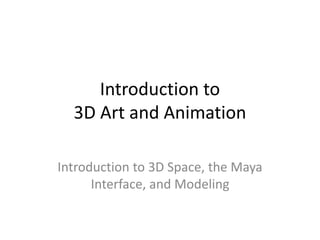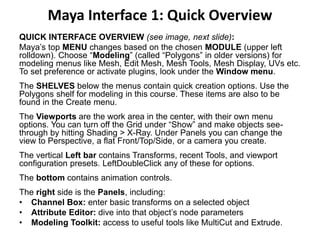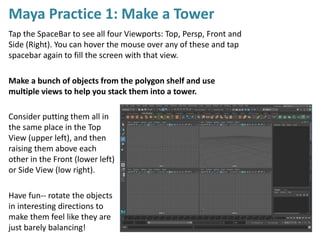Maya is 3D art and animation software commonly used in film and games. It provides tools for modeling, texturing, rigging, animation, rendering, and visual effects. The interface includes menus, shelves, viewports, and panels to transform and edit 3D objects. Basic modeling techniques in Maya include using the polygon shelf to create objects, transforming objects using the move, rotate, and scale tools, and editing object components like vertices, edges, and faces.




![Maya Interface 3: Viewport/Object Controls
Note the upper-right Perspective (Persp) viewport, meaning distant objects
appear smaller. Use a 3-button mouse, hold down [Alt] + a button to change
the view (NOTE: treat middle as BUTTON to Pan the camera, not as a wheel):
Change the Viewport Camera Location and Angle:
Orbit: [Alt]+LeftClickDrag mouse.
Pan: [Alt]+MiddleBUTTONclickDrag
Zoom: [Alt]+RightClickDrag (choppy zoom = scroll the middle wheel).
Change the Viewport Camera Type:
In the last viewport menu Panels, choose an Orthographic (top, front, side,
bottom) or Persp view. Change back to original Persp view for now.
Create Geometry from the Polygon Shelf (top). Start with a box.
Change the display mode of the selected viewport with number keys:
[4] = Wireframe, [5] = Surface, [6] = Textures, [7] = Lighting.](https://image.slidesharecdn.com/3dlessonaintromayamodeling-240310181937-c9613fe9/85/3Dimention_lessonA_introMayaModeling-pptx-5-320.jpg)
![Maya Interface 4: Viewport/Object Controls
We use Object Transforms to change objects we
create: [w]= move, [e] = rotate, [r]= scale
MOVE: Gizmo has 3 arrows/axis for up-down (Y=
green), side-to-side (X=red), and forward-back
(Z=blue). LeftClickDrag an axis to move the object
in that direction (selected=yellow). You can also
LeftClickDrag the blue square at the gizmo center
to move in an orthographic view (top, front, side),
but use axis-arrows for precision in Persp view.
ROTATE: 3 circles making a gimbal ball. Each circle
goes around an axis, for example the green circle
at the equator is around the vertical Y axis.
SCALE: Click the center block (light blue, or yellow
when selected) to scale UNIFORMLY (equally in
all dimensions, no distorting). Click a single axis to
scale NON-UNIFORMLY (to stretch or squash the
object only in that direction).](https://image.slidesharecdn.com/3dlessonaintromayamodeling-240310181937-c9613fe9/85/3Dimention_lessonA_introMayaModeling-pptx-6-320.jpg)

![Maya: Change the Pivot
By default, the pivot location on most objects is in their center. This means if
you rotate an object, it rotates around the center. If you want to rotate
around a side, like opening and closing a door, you need to move the pivot:
1. hit [d] to get the special gizmo for pivot changing, grab an arrow and
move the pivot where you want it to go.
2. As always, orbit around your view ([Alt]+LeftClickDrag) to see your object
from multiple directions and check your placement.
3. Hit [d] again to return to the normal transform gizmos (it is a toggle)
This can also be used to scale an object sitting on the ground so that it “scales
upward” and stays on the ground, rather than scaling outward and needing to
be repositioned: hit [d] and move the pivot to the base of the object.
When you Combine or Boolean objects, the resulting new pivot is usually in
the world center (0/0/0), regardless of where the object is located.
To quickly put the pivot in the center of a selected object, go to the Modify
menu and choose Center Pivot. The you can hit [d] to further adjust.](https://image.slidesharecdn.com/3dlessonaintromayamodeling-240310181937-c9613fe9/85/3Dimention_lessonA_introMayaModeling-pptx-8-320.jpg)
![Maya: Object Inputs and Duplicate
Create a box (Polygon Shelf), stay selected, see the Channel Box (right panel)
ENTER TRANSFORMS: At the top of the Channel Box panel (on the right) note
the Transforms at the top: specific axis channels for Move, Rotate, and Scale.
You can type a value directly into these channels and hit [Return]. You can
also drag dynamically: If you select one or more Channels by name (LeftClick
on the name, or LeftClickDrag to select multiple names), you can then
MiddleMouseClickDrag in the Viewport to scroll through values on those
Channels!
ENTER INPUTS: Scroll down the Channel box to see Inputs. Click the object
name below inputs to open parameters for that object, including size/shape
and subdivisions. Try increasing your box size. Set all subdivisions to 3x3x3, to
cut two lines around the box on every side (see example next screen).
DUPLICATE: To copy an object, select it and hit [Ctrl]+[d] and then use the
Move [w] tool to pull the copy away. Note by default the duplicate lacks the
Input node. You can make a duplicate that also has the Input node by clicking
that option under Edit menu > Duplicate Special (where you can otherwise
create an instance relationship and/or a mirror by setting a scale axis to -1).](https://image.slidesharecdn.com/3dlessonaintromayamodeling-240310181937-c9613fe9/85/3Dimention_lessonA_introMayaModeling-pptx-9-320.jpg)

![Maya Component Transforms
ENTER COMPONENT MODE: RightClickHold on a selected object to choose a
component: Vertices, Edges, or Faces. Then select a part of the object and
Transform (Move [w], Rotate [e] or Scale [r]) that part.
SELECT either by clicking-on or selecting-around. You can add to your selection by
holding [Shift] while you click on or select around other parts of the object.
Remove a part from your selection by holding [Ctrl] while clicking on the part.
[Shift]+[Ctrl] while selecting around ensures previously selected areas do not get
deselected, which holding [Shift] alone can do.
NON-UNIFORM FLATTEN: Use Non-Uniform Scale to flatten components: Select a
bunch of vertices and choose the axis that is perpendicular to the flat surface you
want to make. Click and drag that axis to flatten the vertices into a single plane!
SELECT A LOOP OR RING: In Edge component mode, LeftDoubleClick an Edge in
the middle of your box to select the edge loop around the form. To get a ring,
select an Edge, then [Shift]+LeftDoubleClick a parallel Edge. You can also select a
Face and [Shift]+LeftDoubleClick a neighboring Face to get a ring of Faces.
EXIT COMPONENT MODE: To stop working on the components of one object in
order to work on another object, you need to get out of component mode and go
to Object Mode: RightClickHold on the object to choose Object Mode, and then
LeftClick at empty space in the Viewport to completely deselect that object.](https://image.slidesharecdn.com/3dlessonaintromayamodeling-240310181937-c9613fe9/85/3Dimention_lessonA_introMayaModeling-pptx-11-320.jpg)
![Maya Modeling Tools 1
MODELING TOOLKIT: Switch from Channel Box to the Modeling Toolkit, upper right.
At the top, easy buttons for choosing components (Vertex, Edges, Face) or Object
Mode. Below are lots of useful tools for revising your model:
EXTRUDE: Select one or more Faces, hit Extrude, and pull out new geometry. Transform,
then hit extrude again! Or, select faces and hold [Shift] to drag-Extrude.
CONNECT: Select two or more parallel Edges, hit Connect to draw a line perpendicular
between them. In parameters below, change number of lines drawn. If you select 2
vertices, Connect will draw a line between.
MULTICUT: Cut lines anywhere on your model. Must END on a line or vertex. Hit [Return]
to end one cut and start the next! Hit [W] to end a cut by switching to the Move tool.
BRIDGE: Select opposite Edges or Faces and create bridging geometry between them.
BEVEL: Select an Edge at a corner to make it many Edges, resulting in a curved corner.
Select the four vertices of a square to make them into 8 vertices in order to extrude a
more rounded shape (circle the square!).
TARGET WELD: Select a Vertex, LeftClickDrag a yellow indicator to a target / destination
vertex, release to snap and weld that Vertex to the destination. Also works with edges!
COMBINE: Select two objects in Object Mode and hit Combine to make them a single
object. Then Bridge Edges/Faces or TargetWeld/Merge Vertices between them!](https://image.slidesharecdn.com/3dlessonaintromayamodeling-240310181937-c9613fe9/85/3Dimention_lessonA_introMayaModeling-pptx-12-320.jpg)
![Maya Modeling Tools 2
Important Menu tools (NOTE: Stay in Modeling Module):
Mesh menu:
FILL HOLE (Edges): LeftDoubleClick an Edge of a hole to select hole ring. Hit Fill Hole to
create a polygon connected to all sides. Fails if mesh has interior geo or doubles Vertices.
Edit Mesh menu:
MERGE (Vertices): Weld together all selected vertices within a certain distance
threshold. By default this is set low, perfect for removing doubled vertices caused by
accidental/un-pulled extrusion. Select around all or some vertices and hit Merge.
COLLAPSE (Edges): Turn a selected edge to a vertex, located at the old edge center.
Mesh Tools menu:
CREATE POLYGON: In Front, Top, or Side Viewports, draw the outline of a desired 2d
shape using as few vertices (LeftClicks) as you reasonably can. Hit [Return] to complete
the shape. You can then select the face and extrude!
Mesh Display menu:
SOFTEN/HARDEN (Edges): Select around all edges and hit Soften or Harden edges to
remove or add the appearance of facets or hard seams to your model.
REVERSE (Faces): Select all faces on a black-appearing model to flip “Normals” (Normals
are the direction the surface faces. Should be outward, but can accidentally get flipped,
like a Create Poly extruded in the wrong direction).](https://image.slidesharecdn.com/3dlessonaintromayamodeling-240310181937-c9613fe9/85/3Dimention_lessonA_introMayaModeling-pptx-13-320.jpg)

![Maya: How to Fill Holes
3D Modeling is a process of solving problems by combining the
provided tools into techniques. There are many solutions to
most geometry problems, and deciding which to use is
sometimes based on circumstance and sometimes purely by
artist preference. For example here are 3 ways to fix a hole in
your mesh:
FILL HOLE: In Edge Component mode, Double click an edge to
select around the hole, then in the Mesh menu click “Fill Hole.”
Only works on clean geometry.
OR: BRIDGE: Select an Edge on one side of the hole, [Shift]+
select an edge on the opposite side, and hit Bridge.
OR: STRIP MODELING: Select an Edge on one side, hold [Shift]
for Extrude and PULL OUT a plane (dynamic edge extrusion,
called “Strip Modeling”). TargetWeld the new Edge to an Edge on
the opposite side.](https://image.slidesharecdn.com/3dlessonaintromayamodeling-240310181937-c9613fe9/85/3Dimention_lessonA_introMayaModeling-pptx-15-320.jpg)


![Maya Practice 3b: Extrude a Chair From 1 Box
EXTRUDE LEGS: In the Persp view switch to Face component
(RightClickHold), orbit to view the bottom ([Alt]+LeftClickDrag), and
select the four bottom corners (Hold [Shift] to add to selection). In
the Modeling Toolkit, hit Extrude once and use the Move tool (W) to
pull the new legs straight down to your desired length.](https://image.slidesharecdn.com/3dlessonaintromayamodeling-240310181937-c9613fe9/85/3Dimention_lessonA_introMayaModeling-pptx-18-320.jpg)



![Maya Practice 5a: Make a Wooden Dinosaur
With Create Poly we start a model with a
complex shape and Extrude:
1. Start in the Front Viewport.
2. Activate Mesh Tools > Create Polygon.
3. Draw the outline of your dinosaur by
LeftClicking (to make a vertex, immediate
release) and moving the mouse (to choose
the next place to LeftClick).
4. Use as few vertices as possible to outline
the rough form. Go all the way around and
just before you get back to the start hit
[Return] to finish the shape.
5. Make adjustments in the Vertex
Component mode with the Move tool. Use
MultiCut to draw more vertices if desired.
In the Persp Viewport use the Face
component mode to select the entire shape
and Extrude out the form. Go to Object Mode
and you are done making a flat wooden toy
dinosaur!](https://image.slidesharecdn.com/3dlessonaintromayamodeling-240310181937-c9613fe9/85/3Dimention_lessonA_introMayaModeling-pptx-22-320.jpg)
![Maya Practice 5b: Make a Wooden Dinosaur
For a more rounded form with all 4 legs, remove the 2
legs, Extrude torso from either side, re-Extrude legs:
1. Use MultiCut or Connect to draw lines between the
two vertices at the top of each leg (on both sides)
to make the legs separate faces from the rest of the
body (note: if these tools are not working, you may
have accidentally extruded multiple times, thus
creating extra vertices. Select around all vertices
and hit Edit Mesh > Merge).
2. In Face mode select legs, hit [Delete], DoubleClick
the hole edges and hit Mesh > Fill Hole.
3. In Vertex mode use MultiCut or Connect to
separate the tail and the neck from the body, then
select the body and Extrude on both sides.
4. At the bottom of your model there are now four
spaces. Extrude the new legs.
5. Use Edge-Connect on the legs to add knees, select
all edges and Mesh Display > Soften Edge.](https://image.slidesharecdn.com/3dlessonaintromayamodeling-240310181937-c9613fe9/85/3Dimention_lessonA_introMayaModeling-pptx-23-320.jpg)

